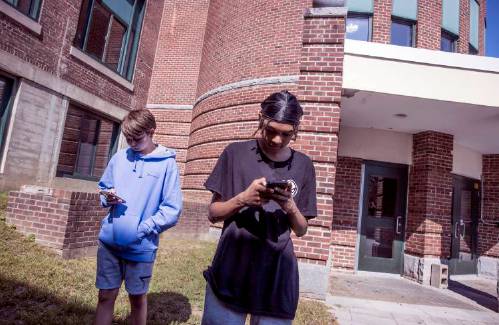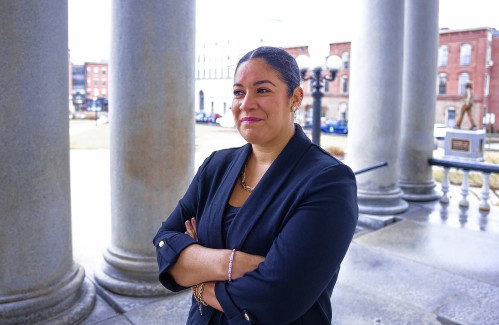
‘Love where you live’ – Market Days kicks off 51st annual festival
Lindsay Frappier has strolled down Main Street on Market Days for years with her husband and their dog, stopping at different stalls, chatting with vendors and, most of all, reveling in the abundance of food to try.

Protesters stage ‘read-in,’ urging Ayotte to veto ‘book ban’ bill
Heather Barber has read “To Kill a Mockingbird” cover-to-cover at least six times.
Most Read
 Boutwell’s is now the biggest candlepin center in the state
Boutwell’s is now the biggest candlepin center in the state
 Home buying gets tougher as prices in New Hampshire continue to rise, outpacing national increase
Home buying gets tougher as prices in New Hampshire continue to rise, outpacing national increase
 Police investigating decomposed body found near Memorial Field
Police investigating decomposed body found near Memorial Field
 Reclaiming Healy Park: A symbol of renewal and a reckoning with homelessness in Concord
Reclaiming Healy Park: A symbol of renewal and a reckoning with homelessness in Concord
 Keep cool Concord: Four city pools open to residents and non-residents
Keep cool Concord: Four city pools open to residents and non-residents
 Pedestrian struck in Pittsfield, officials treat death as suspicious
Pedestrian struck in Pittsfield, officials treat death as suspicious
Editors Picks
 A Webster property was sold for unpaid taxes in 2021. Now, the former owner wants his money back
A Webster property was sold for unpaid taxes in 2021. Now, the former owner wants his money back
 Report to Readers: Your support helps us produce impactful reporting
Report to Readers: Your support helps us produce impactful reporting
 City prepares to clear, clean longstanding encampments in Healy Park
City prepares to clear, clean longstanding encampments in Healy Park
 Productive or poisonous? Yearslong clubhouse fight ends with council approval
Productive or poisonous? Yearslong clubhouse fight ends with council approval
Sports

Athlete of the Week: Nate Kiah, Bow Falcons
Bow High School senior pitcher Nate Kiah had a stellar season on the mound and was a part of many deep playoff runs during his varsity career.
Opinion

Opinion: Iran and Gaza: A U.S. foreign policy of barbarism
When I swore an oath to enlist in the military, one important statement I’m to uphold is the “… I will support and defend the Constitution and laws of the United States of America against all enemies, foreign and domestic.”
 Opinion: There’s no place like firearms-free zones
Opinion: There’s no place like firearms-free zones
 Opinion: Outlines of a new dystopia
Opinion: Outlines of a new dystopia
 Opinion: Speechless in America no more
Opinion: Speechless in America no more
 Opinion: Friends don’t let friends drive drunk
Opinion: Friends don’t let friends drive drunk

Your Daily Puzzles

An approachable redesign to a classic. Explore our "hints."

A quick daily flip. Finally, someone cracked the code on digital jigsaw puzzles.

Chess but with chaos: Every day is a unique, wacky board.

Word search but as a strategy game. Clearing the board feels really good.

Align the letters in just the right way to spell a word. And then more words.
Politics

New Hampshire school phone ban could be among strictest in the country
When Gov. Kelly Ayotte called on the state legislature to pass a school phone ban in January, the pivotal question wasn’t whether the widely popular policy would pass but how far it would go.
 Sununu decides he won’t run for Senate despite praise from Trump
Sununu decides he won’t run for Senate despite praise from Trump
Arts & Life

Meet Moriah Billups, Young Professional of the Year
Moriah Billups has been named the Young Professional of the Year by the Greater Concord Chamber of Commerce. Billups, 32, currently lives in Hooksett and works at Concord Hospital Trust as a philanthropy office. She was honored at the Chamber’s Pinnacle Awards in early June and previously was named Young Professional of the Month in February 2023.
 Artist spotlight: Leah Kuehne
Artist spotlight: Leah Kuehne
Obituaries
 Francis C. Evans Jr.
Francis C. Evans Jr.
Francis C. Evans, Jr. Palm Coast, FL - Dr. Francis (Fran) C. Evans Jr. passed away peacefully on May 14th, 2025 at the age of 86 years. He will be greatly missed. He was born December 12th, 1938 and spent his early life in Staten Isl... remainder of obit for Francis C. Evans Jr.
 Roberta Trombly
Roberta Trombly
Roberta (Bobbie) Trombly Loudon, NH - Roberta (Bobbie) Trombly passed away on June 17, 2025. She was born on July 23, 1936, in Penacook, NH, to Frederick and Annette O'Keefe. She is predeceased by her husband, Paul Trombly, who passed a... remainder of obit for Roberta Trombly
 Timothy Patrick Deal
Timothy Patrick Deal
Concord, NH - A Tribute to a Life Well Lived It is with great sorrow that we announce the passing of Timothy Patrick Deal, formerly of New Hampshire, who departed this world far too early on May 10, 2025. Tim passed quietly in his home... remainder of obit for Timothy Patrick Deal
 Marilyn B. Ross
Marilyn B. Ross
Concord, NH - Marilyn B. Ross; 96, of Concord, formerly of Pembroke, passed away on Sunday, June 22, 2025, at Presidential Oaks in Concord, following a period of declining health. She was born on April 25, 1929, in Natick, MA; daughter... remainder of obit for Marilyn B. Ross


 Lawmakers reach deal on $16 billion two-year budget
Lawmakers reach deal on $16 billion two-year budget
 Concord school leaders grapple with lunch debt exceeding $100,000
Concord school leaders grapple with lunch debt exceeding $100,000
 Suspect in Hampton Beach shooting arrested in Deerfield following police pursuit and shelter-in-place order
Suspect in Hampton Beach shooting arrested in Deerfield following police pursuit and shelter-in-place order
 Culvert replacement at Bow Brook in Concord
Culvert replacement at Bow Brook in Concord
 Scott Brown announces bid for U.S. Senate seat vacated by Jeanne Shaheen
Scott Brown announces bid for U.S. Senate seat vacated by Jeanne Shaheen
 Concord Police accuse Barnstead man of vehicle theft after chase through city
Concord Police accuse Barnstead man of vehicle theft after chase through city
 Department of Corrections running $10.8 million past its overtime budget in 2025
Department of Corrections running $10.8 million past its overtime budget in 2025
 Special legislative session approved amid Ayotte’s budget standoff with GOP lawmakers
Special legislative session approved amid Ayotte’s budget standoff with GOP lawmakers

 Track & field: Hopkinton’s Lane wins New England title in 3,200 meters, Concord’s Saysaw runs state record times in 100 and 200
Track & field: Hopkinton’s Lane wins New England title in 3,200 meters, Concord’s Saysaw runs state record times in 100 and 200 Boys’ Lacrosse: Bears narrowly lose to Plymouth in D-III championship, 7-5
Boys’ Lacrosse: Bears narrowly lose to Plymouth in D-III championship, 7-5 Boys’ volleyball: Coe-Brown wins program’s first championship, completes perfect season
Boys’ volleyball: Coe-Brown wins program’s first championship, completes perfect season Baseball: John Stark falls in D-II championship to top-ranked Souhegan
Baseball: John Stark falls in D-II championship to top-ranked Souhegan Concord became a Housing Champion. Now, state lawmakers could eliminate the funding.
Concord became a Housing Champion. Now, state lawmakers could eliminate the funding. ‘A wild accusation’: House votes to nix Child Advocate after Rep. suggests legislative interference
‘A wild accusation’: House votes to nix Child Advocate after Rep. suggests legislative interference  Town elections offer preview of citizenship voting rules being considered nationwide
Town elections offer preview of citizenship voting rules being considered nationwide “A Time to Gather Stones,” based on a local historical crime, premieres in Pittsfield
“A Time to Gather Stones,” based on a local historical crime, premieres in Pittsfield Making music: Contoocook-raised Derek Astles celebrates new album, old collaborations
Making music: Contoocook-raised Derek Astles celebrates new album, old collaborations 2025 Brodsky Prize for Excellence in Student Journalism awarded to Londonderry junior
2025 Brodsky Prize for Excellence in Student Journalism awarded to Londonderry junior 
